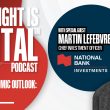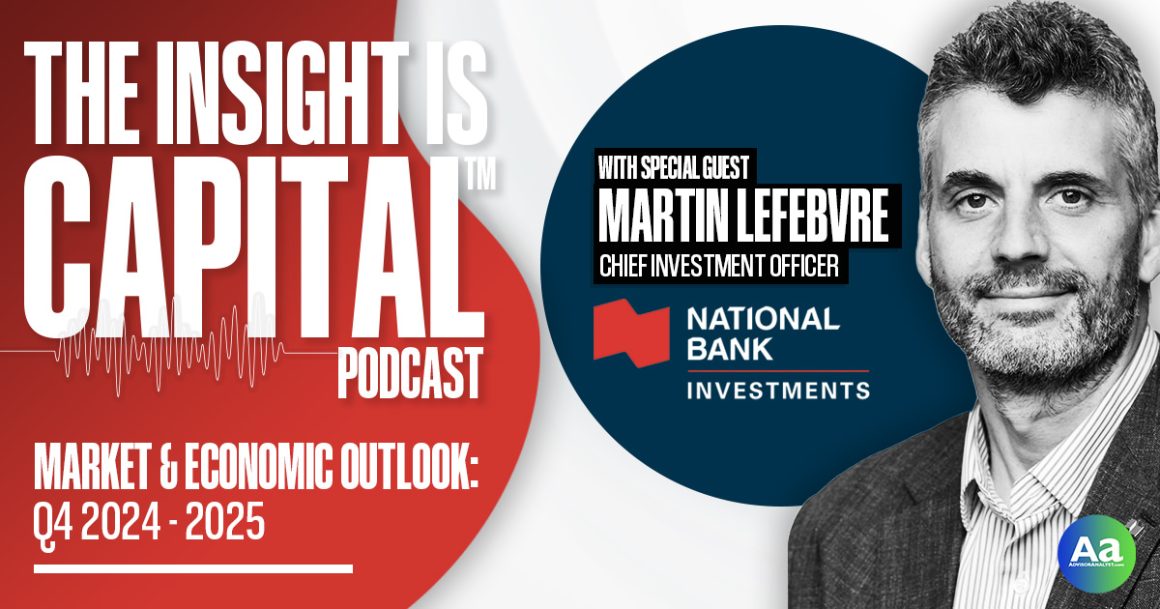Announcement: [00:00:00] This is the Insight is Capital podcast.
Announcement: The views and opinions expressed in this broadcast are those of the individual guests and do not necessarily reflect the official policy or position of advisoranalyst. com or of our guests. This broadcast is meant to be for informational purposes only. Nothing discussed in this broadcast is intended to be considered as advice.
Pierre Daillie: Welcome back to Insight is Capital. I’m your host, Pierre Daillie. In this episode, Martin Lefebvre, Chief Investment Officer at National Bank Investments, joins me to talk about his team’s take and outlook for the economy, fixed income, and equities. Martin has over 20 years of experience in financial markets where he has held various key positions.
He joined National Bank in April of 2012 as a strategist before moving on to private banking 1859 where he oversaw. The portfolio management team as Chief Investment Officer, he is now responsible for the development of investment solutions for national bank investments and the management of tactical asset [00:01:00] allocation mandates.
Prior to his years at the bank, he worked at NatCan investment management as vice president asset allocation, where he was responsible for the portfolio management of several multiple asset class mandates. Thank you again for joining us. And without further ado, my conversation with Martin Lefebvre.
Martin, welcome back to the show. And thanks so much for joining us at this moment.
Martin Lefebvre: It’s my pleasure as always, you know.
Pierre Daillie: It’s great to have you back again. This is your, uh, your second time on the show. It’s been quite a year. Um, US stocks are at all time highs. Uh, long term bond yields have been falling as markets signaled weakness during the past two quarters.
All in the context of a still strong labor market. Albeit with unemployment rising a little bit, and it’s been a tale of two cities, one dominated by net savers, the other by net borrowers, and inflation, stubborn [00:02:00] inflation, subsiding, but still continuing to cause a fair amount of uncertainty.
Martin Lefebvre: Absolutely.
Some investors are surprised to see that the markets where they’re sitting right now with new eyes on the S& P 500, there’s been a, a little bit of, um, leadership change, um, as of late, the magnificent seven. You know, are, um, are lagging a little bit, um, ever since the, um, uh, change in the, uh, labor market, the softening of the labor market, uh, sometime in, uh, July, uh, and the expectations of rate cuts.
And, uh, obviously we’ll talk about that in length in a, in a couple of, uh, in a couple of minutes, but I guess. After the pullback that we got in 2022, following the start of this unprecedented, um, monetary tightening, I guess we shouldn’t be surprised to see that the markets are behaving the way they are, [00:03:00] especially knowing that inflation has come down markedly while Um, economic growth, economic growth in the U S has remained very robust above, uh, potential almost at 3%.
And when you look at stats like, uh, GDP, now it’s, it’s still forecasting that the, the third and fourth quarter will be fairly strong. So it’s, it’s not really surprising and perhaps. Um, out of the norms, uh, following, um, a monetary tightening the way we, uh, we saw.
Pierre Daillie: Well, finally, I mean, finally markets got the highly welcome Fed rate cut in September.
And what do you think was behind the Fed’s bold decision to go with the 50 beeps cut? To kick off easing.
Martin Lefebvre: Yeah, it was a bit of a surprise. Uh, it was coin toss. Some people were expecting only 25, 25 bips. I think that the fair was ready already in, uh, in, uh, in July, but they wanted to wait for a little bit more information.
And, uh, I guess, uh, [00:04:00] uh, there was just ready. And with the softening of the job market in, uh, in July, as I said, uh, in, in the introduction, uh, it was time for them to, uh, to cut rates. So they did that. Um, If we go back in time a little bit, uh, and recall the, the Fed’s objective to, to engineer a soft landing, um, you know, with inflation coming down, it was time for them to, uh, focus their attention on the unemployment rate, which has gone up a little bit over the past couple of months, uh, to a point where it was.
Uh, important for them to, to switch gear and say, we’ve done our job mission accomplished on the inflation front. And now we don’t want, and it was very, um, uh, Powell was very adamant saying that we don’t want the unemployment rate to deteriorate much more from this point on. Uh, so it was, it was obvious that there were, there was going to be some rate cuts.
Now, was it, was the, the 50 bits necessary? I think that it [00:05:00] was, if you want to engineer a soft landing, obviously it’s, uh, it’s a state, so what’s the, what’s the soft landing? Well, you, you want to make sure that inflation comes down, but without provoking a recession. So if you want in a economic growth to remain above potential, then You, you need to have, um, you need to have the neutral rates somewhere around, uh, 3%, much faster than what was, uh, expected by market.
So they, they kind of said that, but I don’t think that the 50 bps is necessarily the way to go in the near future. They might be. Decide to go by, uh, down by 25 biths, uh, in the, in the next, uh, next Fed decision in, which will be at the end of October, just to see how it goes. And if, uh, if, um, uh, the job market remains fairly robust or if there’s a further deterioration in the unemployment rate,
Pierre Daillie: Well, yeah, I mean, it was quite a nice surprise.
[00:06:00] Um, I think, you know, It was, it was so highly anticipated for so long. And finally, you know, at least, uh, you know, it, it appears that the Fed is doing a little bit of catch up as well, too, in terms of catching up to the rest of the developed world economies, having started their cutting, like Canada, for example, cutting much, much sooner.
Uh, than, than the U. S. was prepared to move. So, Maltan, what, what do you think is in store for long term yields and your fixed income strategies, especially given some of the economic fragility that we’re seeing?
Martin Lefebvre: Yeah, that’s a good question, and, um, you probably saw that following the, uh, Fed decision that the, the, the rate market didn’t move very much.
Uh, it remained fairly stable, and I guess, uh, In that 50 BPS reduction, there’s, there could be two things. Uh, we were waiting for the decision. Um, wondering what a 50 BPS, you know, rate cut would, would [00:07:00] have in terms of implication for the markets. And it was kind of twofold. Um, obviously if the message was strong that there.
The work was done and that inflation had come down, you know, enough to a point where they were in a position where they could lower interest rates to, to maintain that perception of soft lending. We thought that that would be good. And obviously we saw that the stock market went up, you know, to, to new eyes.
So that’s a clear positive, but for the bond market, the reaction was kind of a different because now it’s okay. There’s going to be a soft lending. If there’s a soft lending, then. Perhaps inflation is not going to come down, you know, as, as much as, uh, as, uh, as it, uh, possibly, uh, could in a, in a recession scenario.
And just because of that, we saw that yields have started to stabilize around the current level, but then there was a lot already priced in that, that softening of the labor market probably was already priced in a yield that come [00:08:00] down, not from a. Uh, a recent high of nearly 5%, but probably 50 bits lower than what it was.
Um, just about a month and a half ago. So for us, it seems that yields may not have to go, you know, much lower from this point on, but for us, the risk in this scenario is to the downside. Right. Um, you probably recall that, uh, With the softening of the labor market, there was this triggering of what we call the Sam rule.
Sam rule is, uh, when there’s a deterioration of a half percentage point in the unemployment rate from its level, uh, a year ago. And historically it has always led to some form of slowdown or worst of recession. All the way go, if you go back all the way to the 1960s, it’s infallible almost. So we have to.
We have to monitor that very closely. We have to listen to this, uh, signal, [00:09:00] but it doesn’t mean that, you know, it could be the exception to the rule. And right now, what we’re seeing is that the stock market is, is there, um, the, the consumers are still there, even though the, that the job market is, has deteriorated a little bit, uh, the unemployment remains at a fairly low level.
It’s almost, it’s still at full, full level. You know, employment almost, uh, as we speak today, um, wages are still there. So there, there, there isn’t that much risk that could have the, uh, the U S economy tilt in a, in a full blown recession. So we still have to monitor that. But for, for, for this time being, it seems that even though risk remained tilted to the downside, that go in, go out.
Very long duration in our bond strategy is not, doesn’t seem to be appropriate this time around.
Pierre Daillie: Right. What are you doing to adjust your asset allocation to navigate this recession risk? Where are you targeting duration in your fixed income [00:10:00] portfolios?
Martin Lefebvre: Yes, we’re still slightly over with duration, but I’d say, let’s say your, um, your benchmark is seven years, which probably like half a year, one year at most, uh, over duration in terms of, uh, as allocation, uh, we’re still neutral.
In our global positioning in terms of stocks and bonds, uh, most of our models are pointing to that, whether it’s, um, um, the momentum is still there in the equity markets, that’s for sure. But if you look at the cyclicality, if you look at manufacturing, that’s slowed down a little bit. If you look at many things that we tend to look at as strategists, it’s kind of telling you that.
Risk are, you know, remain tilted to the downside. So, um, you know, like I said, there might be an exception to the rule in terms of the triggering in a SAM rule, but it’s the same thing in terms of monetary tightening, usually the fed, they always wait at the last minute before they start lowering interest rates.
So the fact that they’ve done that just now. [00:11:00] Historically, it’s always been, uh, an indication that it’s too late and that there’s going to be a recession. Now you have to recall, why hasn’t there been a slowdown yet? You know, the, the monetary tightening started nearly two years ago. And, um, uh, actually more than that, it’s, it was in March of 2022, but the, the, um, uh, monetary policy became restrictive about two years ago.
And yet we haven’t seen. Uh, the, the, the slowdown or, uh, or what’s the recession just yet. And part of that is linked to the fact that while the Fed was hitting the brakes, then the government was, you know, full blown, uh, pedal to the metal to building huge deficits and trying to. Uh, kickstart the economy with all sorts of bills, uh, whether the, uh, the chips act or, uh, the inflation reduction act, sending checks to, uh, households, uh, uh, in the U S so that, that was kind of an offset to what the fit was, [00:12:00] uh, was trying to achieve on one, on the one end.
And then on the other end, uh, perhaps another big offset. Was the fact that, uh, we had all of this excess savings that was built on the part of households in the U S that was utilized to offset the increase in prices over the course of 2022 and 2023. And that, as we know. As is almost completely depleted.
So, uh, we have to be careful in our analysis of the U S economy going forward. There was a few things that were positive that are now gone. It’s going to be very difficult. There’s an election coming. It’s going to be very difficult, whether it’s Trump or Harris, that takes the white house to, to. To build, you know, even bigger deficits going forward, uh, and households will probably be a little bit more, um, prudent in their, uh, in their approach in 2025.
So the risk of a slowdown is still very much present. And that’s why for the time being, [00:13:00] we’re still working with a soft landing scenario, just. Like probably 80 percent of the investors out there, when you look at bank of America, Merrill Lynch, um, uh, fund manager survey, it’s still telling you that most folks out there, investors expect the Fed to engineer a soft landing.
But like I said, historically, it’s always been very difficult for them to, uh, to do that. Um, and, uh, and, uh, and, and that’s, that’s why we, we need to be careful in our approach as well.
Pierre Daillie: I mean, there, there’s some broad differences between, uh, you know, us here in Canada, looking across the border at the U S there’s some broad differences in, in the way that our economies run.
I mean, first of all, lending practices where mortgages are concerned. I mean, you know, a lot of homeowners in the U S have 30 year mortgages that are locked in at, at very low rates, you know, sub four, sub three in some cases. Um, Right. And, and so a lot of the pricing pressure that we saw, [00:14:00] um, you know, didn’t really affect them though.
Even the lagging effects of, of rate hikes didn’t really bother a lot of homeowners in the U S because they were locked in, but here in Canada, it’s a different story, uh, because a lot of mortgages are coming up to their, you know, coming into their five year terms. Uh, you know, and that, that was kind of what I was alluding to at the beginning where, where I said, you know, it’s a tale of two cities, we’ve got, we’ve got You know, all the benefits going to net savers of higher rates, you know, higher yields investments that, that are paying three, four, 5%.
A year and stocks at all time highs. And, and so, you know, net savers have benefited greatly from the dynamics of this economy, but net borrowers, uh, have not right. And, and, you know, where, where net borrowers are under pressure because of, of rates having risen, you know, as much as they did in the last, uh, the last four years.
And only now beginning to subside, um, there’s still, there’s still [00:15:00] quite a lot of lagging effects that, that are creating a fair bit of uncertainty, depending on how quickly the easing happens and how quickly, you know, housing, house, you know, home mortgage rates come down here, uh, this side of the border, but in the U. S. that doesn’t seem to be as much of a concern. But of course, uh, you know, the focus is a lot of the focus is on the, you know, the tightness of the labor market, uh, coming off a little bit and inflation, you know,
Martin Lefebvre: But even in the U.S. Can, if you, it’s, it’s true. I mean, if you have a 30 year mortgage and you, you, you signed up at the, At 1%, I mean, the incentive to say, Oh, no, I want a bigger house.
And I want a mortgage at 7, 8, 9 percent is not really there.
Pierre Daillie: But yeah, people are stuck. I mean, people, people are stuck in their current homes because of their 30 year rates. So mobility is down, right? And the ability to move to another, another city, another job, if you have to, uh, is kind of, it’s not there.
It doesn’t exist. I mean, being able to do that, unless, [00:16:00] unless, you know, you can commute, Um, but for most people that means staying put and, and trying to stay in, in, in your, you know, your current home, your current city.
Martin Lefebvre: But it doesn’t mean that the impact will not happen. Nonetheless, it’s probably slowed down because of that, because of the, the fast increase or unprecedented increase in interest rates, but you know, the economy is still doing well, some folks want to become homeowners and they’ll have to, you know, there’s going to be transactions in the near future.
And even though. The, the rate as, as started to come down, the effective rate will probably continue to go up in the near future. And you know, that, that, that impact on the, um, real estate market, that’s usually much faster, uh, because, uh, real estate is probably the most sensitive, uh, sector of, uh, uh, interest rates, uh, sensitive, uh, the most interest rate sensitive sector, it, it might happen in 2025 so that, you know, that.
[00:17:00] That lagging effect is still there. And like you said, even though it takes time, there’s, there’s, um, it takes time for monetary policy to have an impact on the economy while it’s the same thing. As they’re, as they’re starting to lower interest rate, it’s going to have, it’s going to take time for that to really kickstart the economy.
So, um, for us, the, um, the risk of a slowdown is still very much in place.
Pierre Daillie: Yeah. And there’s still, there’s still even like with the easing that has begun, there’s still also. A chance that inflation could re be become resurgent.
Martin Lefebvre: It could happen. I mean, there’s a, there’s a lot of things that could, um, uh, exert upward pressure, but what we know for a fact is that while commodity prices have come down,
um, so demand for commodities has come down by a wide margin. Oil prices are down and all of, all of those are, you know, usually when you into, uh, uh, a recession. It’s always been a company accompanied in the past by [00:18:00] exogenous upward supply shocks, whether it’s a, um, oil price or something like that. So we’re not seeing that right now.
And that’s, that’s, that’s, uh, that’s, uh, that’s a positive thing, but yeah, so we have, we have to monitor the fact that, uh, inflation may go back up. But the, uh, the fact of the matter is that the, the only thing that remains. Um, robust right now it’s services prices and it’s linked very much to, uh, to wage increases.
And, you know, we know that wage increases have come down and just the fact that the labor market has been softening, uh, the quits rate is down, the hiring rate is down as well. So all of those are pointing to, uh, wage increases that will probably 3%, which historically has always been. Um, uh, coherent with a 2 percent target on total inflation.
So we’re not too worried about that. Um, and, um, and if rates come, I don’t think that we don’t see rates coming down to like [00:19:00] very, To, to a point where it would, it would re, uh, ignite, uh, demand in the U. S. So, um, we’re not too worried for that, at least for the next, uh, 12 to four, 24 months.
Pierre Daillie: All right. And, and so let’s talk about equities, uh, Martin.
With the U. S. election around the corner, what strategies are you implementing to manage the expected market volatility that you mentioned? And how do you see this affecting your current overweight position in U. S. equities?
Martin Lefebvre: Yes. Uh, that’s a question. And, um, of course, every election is different. Um, but there’s, there’s always seems to be, um, a volatility, uh, picking up towards, um, November, and it’s pretty obvious because, you know, there’s a lot of uncertainty surrounding, uh, elections.
So whether. Um, whether it’s Democrats or Republicans, usually it shouldn’t have a big impact unless like in [00:20:00] 2016, Trump announced, uh, that he would lower corporate taxes by a wide margin, obviously you got that for four years. So everything went, um, everything skyrocketed from, from that point on. But usually we don’t.
Tend to pay too much attention to whether it’s Republicans or Democrats. The importance for investors obviously is to be invested all times. Uh, it’s been, it’s well documented that if you only invest while Republicans are at the helm, or if you invest only when the Democrats, you know, you’d be better off just to stay invested, uh, at all times.
So we don’t tend to look at that too much, but it’s going to exert A little bit, a little bit of, um, you know, upward volatility going, uh, going forward, what happened just recently is that, um, if you, I don’t know if you recall the last, uh, debate with, with Biden, uh, that sort of gave, you know, wings to, uh, the, the, the Trump presidency.
[00:21:00] Uh, and the, the, the. The stock market kind of liked that because they, they, they kind of remembered that what happened while he was, uh, was when he was elected president in 2016, but for us, 2016 was, uh, a much different time than what we’re, uh, observing right now. Um, we had just come that come off a little bit of a pullback.
So stocks were oversold. Uh, PE ratios were much lower. Uh, the equity risk premium was better. Folks were. compensated, well compensated for taking the risk. Um, the, um, the fiscal discipline was much higher. I mean, the, there was the, the, the fiscal deficit was almost close to zero and servicing the debt because interest rates were almost at zero at that time.
Was much lower. So it was, it was almost a given for him to just say, okay, I’m going to lower corporate taxes. And that was. That was, that was good for every stock indices, um, around the world. So this time [00:22:00] around, it seems that it’s, it’s got to be much more difficult. Like I said, in the introduction, uh, the difficulty or the, the fact that the, um, uh, the, the fiscal deficits is already somewhere around 6 percent of GDP.
It makes it almost impossible for them to really lower, uh, Corporate taxes, or even also taxes in the, uh, in the near future. So we don’t see Trump being elected as good as what marketer are anticipating. So something that we need to monitor and, uh, embed in our forecast.
Pierre Daillie: Yeah, I mean, so much rhetoric, right?
I mean, if you, if you, you know, consider, if you only considered the rhetoric, I mean, it’s enough to drive anyone crazy. But when you actually, when you actually, you know, look at what it takes to get, um, you know, legislation passed. In the U.S. Uh, the likelihood of things changing dramatically is very, very low.
Yeah.
Martin Lefebvre: Oh, but it’s a close race, you know, just now for the, uh, [00:23:00] for the white house, but then we don’t know what the Senate will be or what the, uh, um, yeah, the Congress will be, it will be like, so, uh, it’s probably going to be a gridlock going, uh, going forward. And then just in terms of election right now, Harris seems to be ahead in the polls, but as we know, it’s usually, you know, there’s six or seven swing states in the U S and elections are always one, uh, within those three, uh, those six is, um, uh, six states.
And it could go, it could go anywhere. So there’s a, there’s a few paths. It’s usually. When, when, uh, whether Pennsylvania or Michigan or Wisconsin are, are, uh, Democrats, it’s, it’s, it’s good. It’s enough for them to have 270 electoral, uh, colleges, but now, I don’t know, it could be, could go anywhere. Yeah, it looks like anyone’s guess right now.
And having too much of an advance, uh, I think would be problematic for, uh, Harris. You know, if, if, [00:24:00] if it’s a given or a no brainer that she’s going to win, people are not going to go out and vote. So there’s still need to have people go out and vote.
Pierre Daillie: Well, the, the angst is good for that. Uh, so, uh, Martin, we’ve seen some rotation towards more defensive sectors.
Um, how do you see this unfolding further? How do you see it evolving? And what adjustments are you considering for your sector allocations?
Martin Lefebvre: And going back to your question earlier about, uh, our overweight us equities, um, that’s why we like the U S even though there’s going to be a little bit of, uh, uncertainty surrounding the, uh, the U S election, it’s not going to last for very long and eventually people will go back to, okay, what’s where should we be, uh, invested.
And, um, the fact that the matter is that. In the U S you got a bit of everything, sort of a barbell strategy where you got the defensive, let’s say there’s going to be, let’s say the risks are tilted to the downside. Right now, everybody’s [00:25:00] believing that the Fed is in a position where they can engineer soft landing.
So that’s, that’s great. And if that happens, then lower rates will probably good for growth stocks or tech stocks, or even the magnificent seven, which are, you know, a bit of a bargain or a lower point or cheaper right now than they were. At their, uh, recent peak, uh, but then if there’s a slowdown and you need to position for that, then the U S is also loaded with more defensive stocks.
So the staples healthcare, uh, utilities will also benefit from probably lower. Interest rates in the, uh, in the near future. So the, the U S is a good, uh, market for that. It’s got, it’s got the growth on the one end, but it also got the defensive sectors on the other end. And for, for us, you know, Canadian investors, it’s, it’s always good to have a mix of, uh, Canadian equities.
And us equities, it’s, it’s like the best weather, whatever weather portfolio that you, um, that you can have. [00:26:00] So we’re, we’re, we’re sticking to our guns and, uh, we remain, uh, overweight, uh, us equities for the, uh, for the near future. And the momentum is there. Even though, like I said, Magnificent and I’ve, I’ve, I’ve tanked a little bit, the rest of the market, the S&P 493, if you want, has, uh, has gone up and is making new highs.
And even the, uh, equally weighted sectors are, are, are doing a little better than, uh, than the, uh, than they have over the past, um, two years or so. So yeah, I mean, for us, it’s still the way to go.
Pierre Daillie: So we’re still seeing expanding breadth. Across, across the other 493 stocks in the S& P 500. That’s right.
Excellent. Um, so with consensus earnings growth projected at around 10 percent for 2024 and 2025, how confident are you that companies will continue to generate this growth against potential economic headwinds?
Martin Lefebvre: Well, it, it, uh, it all comes down to that soft landing scenario. So [00:27:00] if, if that happens, then, and that means the consumer will remain fairly robust.
And if the consumer is there, the spending will, their sales will be there. Uh, and earnings at the end of the day will, uh, will be there. Uh, but it always starts expectations in the market are always for the next year to be, to start at somewhere around 10%. So historically it’s always been that. What’s your expectations for 2026 Piat?
Go with 10%. It’s, it’s a pretty good, it’s a pretty good bet. And then eventually they start to either decelerate or things, you know, improve and they, they go elsewhere. But in a recession year, they always go down to somewhere around zero. And it’s, it’s never happened in the past that we had a slowdown without, um, sort of a pullback in, uh, in earnings.
So for us, it’s, it’s kind of an eye opening because when you look at where, uh, PE ratios are sitting right now. It means that there’s no expansion of [00:28:00] multiple possible at that point. You know, the last time that equities were this expensive was in 1995. So it’s the only other time where, uh, we had a, uh, a PE ratio that was this, uh, uh, this expensive for something to be, uh, careful about.
And for us Risks are tilted to the downside from this point on. So we, we continue to work, you know, we go week by week, month by month with this soft lending scenario. It could be the exception to the rule, but the fact of the matter is that usually when you see the unemployment rates start to.
Deteriorate, it goes, you know, faster than we think. And it’s, it’s quite logic, you know, like you, it takes time to form your employees. It’s very difficult to get access to skilled labor. So you don’t want, you’re going to wait for a few, you know, um, you want to see that your sales are really coming down before you start laying off people, [00:29:00] but if that happens, it could go fairly fast.
So it hasn’t happened just yet. The fact that, uh, the Fed has lowered interest rates. Is, is interesting and pointing in the right direction, but it, it may not be enough to, uh, to really prevent the economy from slowing down. So, like I said, for us, the risk is really tilted to the downside and our analysis has shown that in past, uh, monetary tightening, when the Sam rule has been triggered.
Usually the Fed, which is kind of telling us that they could slow, they could stop somewhere around 2.9% at the end of 2025, right? Would really need to bring rates down to 2%. So, you know, probably, um, a a hundred basis more, uh, of, uh, of rate cuts.
Pierre Daillie: Martin, I just wanted to say, I, I, I love your monthly asset allocation strategy notes.
I think they, they, you know, given what you just said, they, they very well reflect. You know, this month to month watching that you do. [00:30:00] And I really, I really enjoy reading it because it, it, you know, it reflects the changes in, in sentiment and the changes in strategy very nicely with your, you know, your plus and minus, uh, charts.
Um, it’s a, it’s a great resource. So, uh,
so something dramatic would have to change in order for you to make any sort of wholesale adjustments to your strategic asset allocation.
Martin Lefebvre: You mean in terms of geographies or in terms of, um, the stocks and bonds?
Pierre Daillie: In terms of, of, um, what’s happening geopolitically in terms of what’s happening economically, uh, around the globe. I mean, in order for you to…
Martin Lefebvre: Well, there’s lots happening, there’s lots happening around the globe. I mean, if you look at the, the two wars that are, um, ongoing and, uh, don’t, don’t show any sign of, uh, stopping, uh, in the, uh, in the near future, there’s, there’s a lot to worry about, but it’s, it’s more in terms of the economic impact.
That we’re, we’re not really seeing something that will prevent North America from, you know, [00:31:00] continue to always have the example of what’s going to prevent. Apple from selling iPhones or Coca Cola from selling, you know, like colas. And we, we just don’t see it out right now. Um, so the, we think that again, going back to our SL location, prudent approach, we’re neutral.
We’re just waiting to see if there’s going to be, if risks are really going to be tilted to the downside and then it’s. It even if there’s a slowdown or where’s the recession, we still think that it’s going to be shallow in nature and any pullback going forward will be an opportunity to go back in the market.
So that’s why we don’t want to be too defensive. It was a mistake to be defensive in 2023 and parts of 2024. So. Market action is there. You have to, you have to listen to the market that there’s a lot of information just in the market. So we have to listen to the market. Uh, but still we have a prudent approach and most of our indicators are telling us that risks [00:32:00] are tilted to the downside, but we don’t want to go.
Outright defensive in our stance. So neutral, I think is the right approach. And if there’s a pullback, then we’ll, we’ll be ready to, uh, go back, uh, full tilt in the market if, uh, if that happens, basically because we don’t see too many imbalances, right. You know, um, right now. Uh, even though the unemployment rate has gone up, it’s still close to full employment.
There’s no really, uh, crisis that could, uh, get, that could happen, or we’re all, we often refer to the commercial, uh, commercial lending or commercial real estate as a one potential risk, but it’s a small share of the pie in terms of loans. It’s more regional banks that tend to, uh, to do that. So for us, it’s not as.
As, um, you know, it’s not a systematic risk, like, uh, the, the, the, the, the banking crisis, the real estate [00:33:00] crisis that we got in 2007. And if you look at the stock market, yeah, it’s expensive, but then the leadership is in, in super mega stocks. It’s, it’s not like, um, it’s not a dot com bubble or something that, you know, on the verge of, uh, of imploding in my mind, so we don’t see that.
Many, um, risk or imbalances out there that will have, uh, the economy, um, derail to a point where, um, uh, uh, an outright bear market of 30, 40 or even 50% that we got a 2007 is inevitable. So we we’re not there. So for us, any pullback of 10% from, from the, the current level would probably be an opportunity for us to go back in the market.
Pierre Daillie: Interesting. So, uh, Martin, any parting thoughts as we get deeper into October?
Martin Lefebvre: No, we’re gonna be, um, we’re gonna be monitoring, uh, things very, uh, closely. I mean, we always do, but this time [00:34:00] around it seems that, uh, the increased volatility going into the US election and then the, the two ongoing wars, uh, and the developments over there, especially in the Middle East.
Uh, I kind of worrisome. Um, so when the stock market is making new eyes for us, it’s always an opportunity for, for a pullback for, for, for taking profits. We don’t want to get in front of a steam roller for sure. Uh, but, uh, we find that markets are kind of expensive and, uh, there could be, um, world.
Indication of, uh, either consolidation of the market, which would be a good thing or worse, some, some, some form of pullback. So we’re, we’re really need to monitor the, uh, the unemployment rate going forward. Um, just as much as inflation was on everybody’s lips in 2023, uh, we think that, uh, the rest of the year in 2025 will be all about, uh, the labor [00:35:00] market.
Pierre Daillie: Martin, thank you so much. That was, that was very interesting, very comprehensive. Thank you so much for your incredibly valuable time and your insight.
Martin Lefebvre: Excellent. Thank you very much, Pierre. And always a pleasure.
Listen on The Move
Navigating Economic Uncertainty: Insight from Martin Lefebvre
In this episode of the Insight is Capital podcast, we talk to Martin Lefebvre, Chief Investment Officer at National Bank Investments. We explore his outlook on the economy, fixed income, and equities, amid a backdrop of U.S. stock highs, falling bond yields, and changing labor market indicators. We discuss the recent Federal Reserve's 50 bps interest rate cut and its implications, the potential for a soft economic landing, and the intricacies of the U.S. and Canadian housing markets. Additionally, Lefebvre delves into strategies for handling expected market volatility ahead of the U.S. election and the broader implications of global economic factors on investment strategies. Lefebvre provides valuable insights into asset allocation amid economic pressures and highlights the importance of a balanced investment approach in current markets.
00:00 Introduction and Disclaimer
00:20 Guest Introduction: Martin Lefebvre
01:31 Market Overview and Economic Outlook
03:30 Federal Reserve's Rate Cut Decision
06:25 Impact on Fixed Income Strategies
09:52 Recession Risks and Asset Allocation
19:15 U.S. Election and Market Volatility
30:16 Geographical Positioning
35:46 Conclusion and Final Thoughts
Copyright © AdvisorAnalyst














